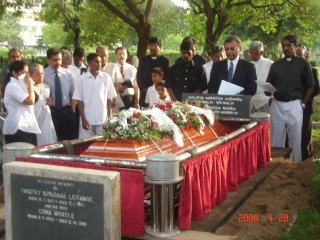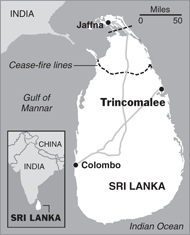 At the gravesite
At the gravesiteMy uncle Felix's funeral was a praise-filled and joyful celebration and as such characteristic of his life. In attendance were large numbers of people, some very influential, from the arts community in Sri Lanka who were mostly Buddhist. I am privileged to have been asked to officiate at the funeral and preach the sermon at the Cinnamon Gardens Baptist Church. My sermon follows
"Christos Anesti"
April 28, 2006
Soren Kierkegaard, the Danish philosopher/theologian once said: We usually think of the preacher and worship leaders as performers and the congregation as the audience. That’s a misnomer. In fact, the preacher, worship leaders and each person in the congregation are performers. God is the audience.
Last Sunday, in Kazakhstan, I watched an Easter service on TV. Orthodox Christians celebrate Easter one week later than Protestants. These are the folks who have elaborate and traditional rituals. I was particularly interested because this service was being broadcast from Baghdad. It was Easter in a war zone!
As the stately and solemn service was nearing its end, the old priest with a long flowing beard came to the front and shouted out – Christos Anesti – Christ is Risen. And the crowd, and yes, it was a crowd, shouted in response – Christ is Risen, Indeed! But that was not enough for the old priest. Christos Anesti, Christos Anesti he repeated over and over again getting more and more animated and starting to jump up and down. And the crowd too was getting excited and they too responded shouting and cheering. And soon the old priest with a dance in his step marched right through the main aisle shouting and cheering and right in to the street and the people following close behind, singing and dancing, and they had an impromptu procession. Even in a desperate war zone – in the midst of all the death and destruction the church proclaimed to the world, loudly and joyfully – there is Hope! Because Christ is Risen!
What happened here? Priest and people were not simply wiling to listen to the Easter story and go home and sleep. That day they dramatized the story.
First it was in the liturgy. Isn’t that what worship is, a way to dramatize the story? Every time we gather as the Body of Christ, every time we sit at the Lord’s table, every time someone gets baptized, we can see this powerful dramatization of the gospel. This priest and people were the performers, and God, the audience, must have been pleased.
But they weren’t willing to stop there. They took the story to the street, to their homes and neighborhoods, even in a war zone! They made that drama the lived reality of their lives. They lived it out!
Drama is a powerful way of telling a story. Few people knew that better than Bappa (uncle), and few people could do it better than he could. Many of you know his accomplishments in that regard better than I do. But my focus right now though is on the other side of the equation: about making the drama the living reality of his life. With that in mind, let me tell you a couple of stories he dramatized with his life.
One of the stories he dramatized with his life is our family’s foundational story of faith. Just as the ancient Israelites have a foundational story of faith in the deliverance from bondage and the subsequent covenant making, and the church has a foundational story which we will celebrate a few Sundays from now on Pentecost Sunday, families do have foundational stories. Some may have to dig deep to find it, but ours was told and retold since we were kids.
This is the story of my grandparents – of how God’s grace was abundantly available to them. My cousins would remember how this story was told to us with such passion. It as almost as if we were ourselves witnesses to those events.
The story is about how God saved my grandfather, a militant Buddhist, from killing a group of Christians on their way to a baptism under a bridge, and thus from the gallows, how that event began a series of events of questioning and struggle, and largely because of the saintly witness and depth of prayer of his Christian wife. The story is about how his militant friends waited at the same bridge to kill him for being a traitor but God again miraculously saved him. The story is too about how under that same bridge and many others he baptized people for over 50 years. God made a covenant with our grandparents. It was a covenant of grace, totally unwarranted on our part.
That assurance of faith, that confidence that the God who came through for us once will come through for us again and again, helps us to know that we act boldly, love generously and live joyfully. If there was anyone who live out that story in that way: boldly, generously and joyfully, Bappa did.
Two more quick examples:
When I was quite young, about 7th grade at Wesley College and he was my headmaster (how many times I’ve had to go trembling to his office and receive canings! Never mind I was his nephew, I think I got whacked harder than others!) In any case, at that time, I had a brief infatuation with writing plays. Perhaps I had seen too much of Minis Gathiya and Deva Varama (Kaluware Jaramare had not appeared yet). He really wanted to encourage me. He came to me and gave me two plot suggestions, and helped me think in creative ways about two old stories: The Good Samaritan and the Prodigal Son. I asked him why these. And I still remember, he said, these are the best stories Jesus told, and that he tries to live by them, and that I should try to bring them to life so others can live by them too.
My plays are still being written! But his drama, he has performed awesomely.
The Good Samaritan Story, you remember, came out when a lawyer tried to question Jesus about how one can inherit eternal life. And Jesus summarized the law and the prophets to him. “Love the Lord you God with all your heart and all your mind and all your strength. And love your neighbor as yourself.”
Now here, you really can’t talk about Bappa without talking about Punchi Amma (aunt) as well. Some of you know that I grew up practically as their 3rd child. I saw their ups and downs. But more than anything, I saw a depth of spirituality that inspired my own faith. If anyone loved God with all their hearts, minds and strength, they did. And they did it together.
The practical expression of that love was their undying commitment to Christ’s church. It was a long-term, disciplined commitment. That commitment was not about seeking acceptance or reward. But a discipline to stay committed even when the church rejected him.
I think they live out their love for neighbor in the hospitality they provided in their house everyday. Remember the flat at Ananda Rajakaruna Mawatha? How can you not, they lived there for 45 years! But the primary reason for that was its central location.
How many children, many of my cousins and I, children of friends, before school and after school stayed there, slept overnight and grew up there? How many people on their way to the General Hospital stopped in for a cup of tea? How many people came to resolve some problem, discuss some issue, get counseled, get prayed for, or even just get fed? Bappa always told me, as he may have told you, there is always extra rice in the house and we can easily make a sambol. Pretty soon that hospitality was so much their lifestyle that they couldn’t and wouldn’t move from there, until it was impossible to stay there!
He told me that I should start the Prodigal son play with the party and do flashbacks. Imagine who would be there, he said. What might they be saying, what kind of music, what kind of jokes, what kind of food. Food was always important to him. He told me that’s why he learned to cook good food, particularly pork!
But that’s how he lived. He lived out the joy of the prodigal coming home and being received with grace. As he lived out that joy his personality exuded laughter. Can you remember one time when he met you and didn’t crack a joke? The party, to him, was the essence of the story: the sheer joy of being received into the father’s house.
If you are not yet convinced about how he lived out the story of Christos Anesti, let me tell you just one more from these recent times.
This January, shortly after he had received the diagnosis of liver cancer, when I called him, he said, “Do you have any messages for your parents?” I laughed, but he was serious. He had begun to take this coming reality long before any of us could even get a handle on it.
About that time he also started quoting Psalm 23. “Yea, though I walk through the valley of the shadow of death…” Sometimes it was hard to know if he was being serious or joking, but we, the rest of the family, couldn’t handle that. So we told him to stop saying it. But he insisted, saying that is indeed his testimony at this time. “Yea, though I walk through the valley of the shadow of death, I shall fear no evil. For thou art with me. Thy rod and staff, they comfort me.” He told us that he has come to terms with the inevitability of this day, and insisted that he was ready and not afraid. But we weren’t ready. We were afraid to talk about it. One night he called me aside and said, “Shantayo, I know I am dying, and we must talk about as a family.” So, I encouraged him to begin the conversation. I think he taught us a lot that day. That we need not be afraid of death, that we need to come to terms with our mortality and we need to trust God more. The following day, at his 80th birthday party he said that, to all his guests. In all that he was living into the story of Christos Anesti.
Family and friends, we’ve had some powerful role models for our faith from my family. From my father, I learned the value of respecting and appreciating those who are different from me, including those whose faith is different from mine. From Uncle Paul, I learned the value of questioning my faith and subjecting it to testing, refining and renewing. From Bappa I have learned the real world, practical ways in which we can live out our faith everyday, and how to do it with unwavering, principled consistency. He taught me how to live out those stories in everyday life. God is good!
Perhaps most of all, I think, he lived out Kierkegaard’s principle. He lived out the stories that gave him life, as a consummate performer. He didn’t do it to please anybody, not his family, his friends or even those who would get angry with him for whatever reason. He would do it only to please God, whom he knew was his only audience.
So, I think God must be wildly applauding today. And if there is a heavenly Oscar, he would be giving his acceptance speech by now. I could almost hear God shouting out – Bravo! Well done, my good and faithful servant. Enter into the joy of your Lord.









